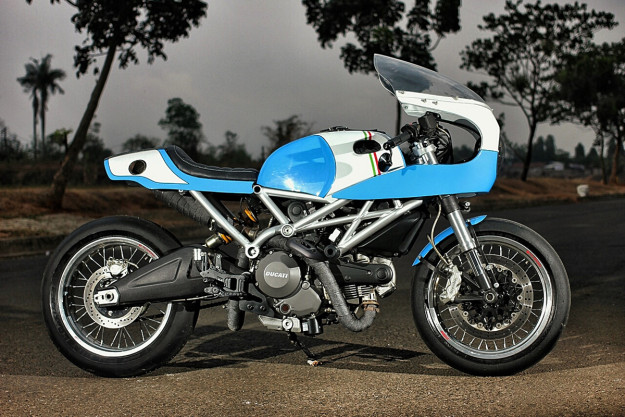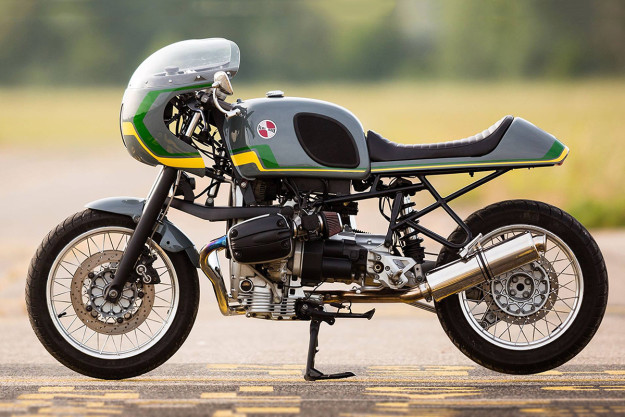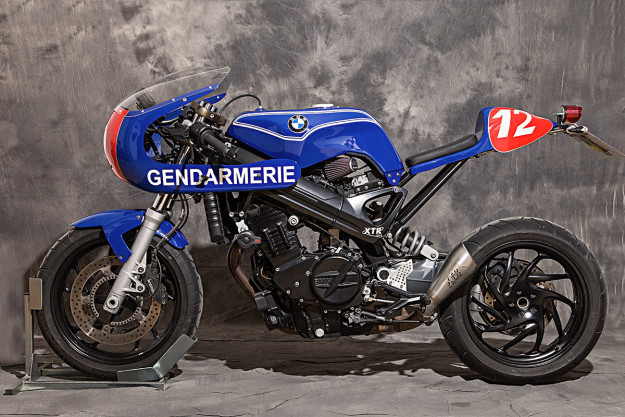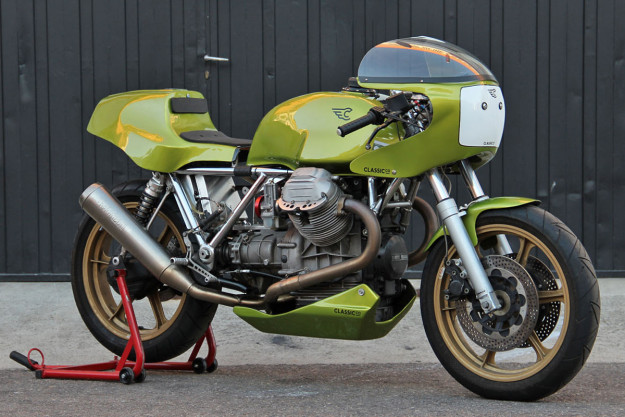
There’s a theme to our latest selection: customs with fairings. From Madrid to the south of France to Japan, here’s the sexy bodywork that caught our eye this week.

Studio Motor Ducati Monster One look at those super sticky Diablo Corsas (especially the shredded one out back) and you know this Ducati Monster 795 can easily run the ton. What you wouldn’t glom onto, however, is that this is only the second cafe build to roll out of Studio Motor. Sophomore efforts are rarely this clean.
The Jakarta, Indonesia-based workshop was quick to shed the Ducati of all its plastics. A new tank, tail and cowl were hand crafted out of 1.2mm steel to deliver a timeless stance, while not taking anything away from the iconic trellis frame. The rear subframe was modified slightly using a 1-inch seamless pipe, ensuring the spine was flat and true. Then the original mag wheels were swapped for spoked units.
The most striking piece of ingenuity, though, is the routing of the in-house devised exhaust, with its MotoGP-inspired symmetrical tail cowling exits. [More]

Flatmaxx Atelier BMW This R1100 cafe racer hails from the Bouches-du-Rhone region in the south of France. The styling is smooth and almost restrained in profile, anchored by an impeccably executed bone line and tightly balanced cut-offs.
There are eighty angry German horses motivating 440-pounds of style, making this machine as swift as the Mistral that blows through the French Riviera. But although this Beemer was built to juke and jive, rider comfort was of the utmost importance too. The suspension was kept compliant, and the seat has a touch more foam than most cafe racers receive. You’ll also notice that proper bars, instead of clip-ons, adorn the cockpit.
It’s a stunning custom that’s way more than somebody’s garage queen. [More]

Yoshida Machine Triton Sometimes a subtle touch is all that’s needed when creating a masterpiece. Here, the Japanese bike builder (and parts manufacturer) Yoshida has captured the spirit of the shed-built hybrids of the 60s with this (slightly) modern interpretation.
True to the original recipe, the Norton Featherbed frame houses a 650cc Triumph twin. But there are also modern updates throughout, to achieve optimal performance without compromising on rider comfort. Carburetion has been updated to use Mikuni units, the rear suspension is a piggyback Öhlins set-up, and the primary belt has been upgraded for reliability too. The cowl was purposely mounted taller than on traditional Tritons; it permits a less-than-full-tuck approach, but doesn’t spoil the silhouette.
In my eyes the attention to details like that creates a true modern classic that might even give Dresda legend Dave Degens pause for thought. [More]

XTR Pepo Interceptor Mk 2 When the checkered flag drops on a build and your starting point was a BMW F800 S, this is not what you’d expect. But then again, Jose “Pepo” Rosell isn’t your typical builder.
Before the Interceptor MK 2 there was a MK 1. It was Rosell’s swansong BMW R80 with the now defunct Radical Ducati—a punctuation mark on a very impressive resume. Thankfully Rosell didn’t hang up his spanners; this F800 comes to us under the XTR Pepo banner, because Jose has continued right where he left off.
The tank is a modified unit from a GSX-R 750—complete with dual aluminum caps—and aside from the Tommaselli clip-ons, everything else was tackled in-house. The subframe, seat, fairing, bracketry, lighting; all of it. If this were the standard issue bike for the Gendarmerie, the recruitment line would start in Madrid. Bienvenido de vuelta, Pepo. [XTR Pepo]

ClassicCo Round Head Racer This heavily modified Moto Guzzi Le Mans II comes from Madrid, and it’s an apex hunter in the truest sense. Because racing is what drives ClassicCo: it’s in the blood of Mauro Abbadini and his team, and you can see it in their every creation.
To shed weight, the Tonti frame has been scrapped in favor of a CroMoly unit, fabricated in-house. It eliminates the need for downtubes and turns the 1100cc V-twin into a stressed member. The swingarm is also CroMoly; crafted for strength and lightness, it’s an inch longer than stock and widened to accept 160-series slicks. The suspension is by fully adjustable Marzocchi units at both ends.
The curvaceous, multi-part bodywork is resplendent in Moto Guzzi’s traditional green, and finished off with a perfect half-fairing. [More]